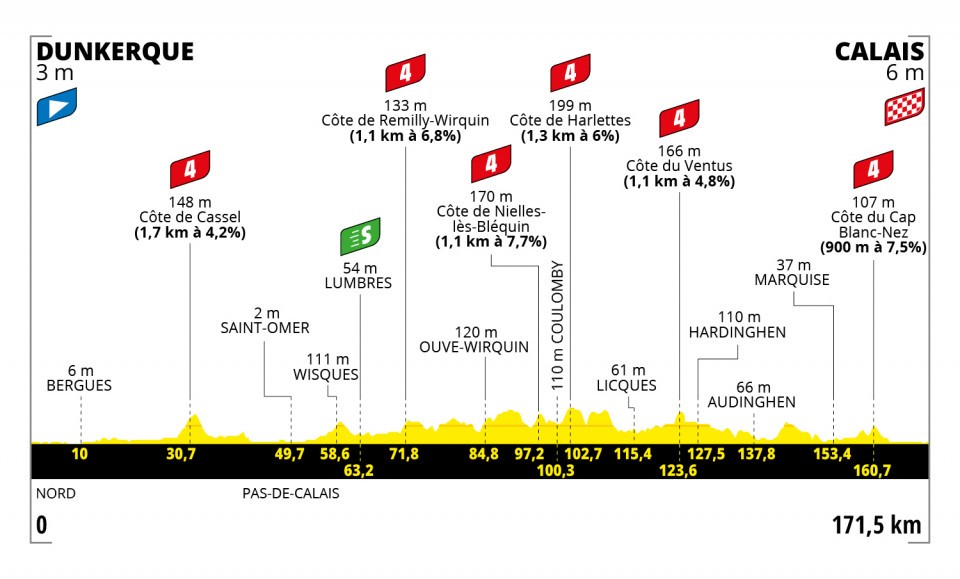STAGE PROFILE

ON THIS DAY IN TOUR DE FRANCE HISTORY
TOUR DE RRANCE MEETS HISTORY
There are few places in continental Europe more related to the English /British history than Calais and Dunkirk.
Calais
Calais served as an English outpost for centuries, located on an island surrounded by marshlands, making it hard to attack from the mainland. The city was enhanced by the Count of Flanders in 997 and fortified by the Count of Boulogne in 1224.
The earliest known reference to Calais comes from its town charter, granted by Mathieu d'Alsace, Count of Boulogne, in 1181 to Gerard de Guelders, officially incorporating Calais into the county of Boulogne. In 1189, Richard the Lionheart is documented to have landed at Calais on his journey to the Third Crusade.
The English wool trade and King Edward III's claims to the French throne led to the Battle of Crécy in 1346, after which Edward laid siege to and captured Calais in 1347. Furious at the town's resistance, the English king initially ordered the mass execution of its citizens. However, he offered to spare them if six of the town's leading citizens would surrender to him, bareheaded, barefoot, and with ropes around their necks, prepared to face death. When they presented themselves, Edward initially commanded their execution but relented after his queen, Philippa of Hainault, pleaded for their lives. Despite sparing the six citizens, Edward expelled most of the French residents and repopulated Calais with English settlers.
Calais earned the title "the brightest jewel in the English crown" due to its crucial role as a key port for the tin, lead, cloth, and wool trades.
The city was regarded for many years as being an integral part of the Kingdom of England, with its representatives sitting in the English Parliament.
In 1532, King Henry VIII of England visited Calais, and his officials estimated that the town had around 2,400 beds and stabling for about 2,000 horses. After this royal visit, reforms were introduced in 1536 to strengthen Calais's connection with England. As part of these changes, Calais was designated as a parliamentary borough, gaining the right to send representatives, or burgesses, to the House of Commons in the English Parliament.
Calais was captured by the Spanish on 24 April 1596 in an invasion mounted from the nearby Spanish Netherlands by Archduke Albert of Austria, but it was returned to France under the Treaty of Vervins in May 1598.
Dunkirk
On 17 October 1662, Charles II of England sold Dunkirk to France for £320,000. The French government then developed the town into a fortified port, modifying its existing defenses with ten bastions. In the 1670s, the port was expanded with the construction of a basin capable of accommodating up to thirty warships, using a double lock system to maintain water levels during low tide. A channel, dug through coastal sandbanks and supported by two jetties, connected the basin to the sea. This work was completed in 1678, and a few years later, five forts—Château d'Espérance, Château Vert, Grand Risban, Château Gaillard, and Fort de Revers—were built to defend the jetties. An additional fort, Fort Blanc, was added in 1701.
During the reign of Louis XIV, Dunkirk became a haven for commerce raiders and pirates, with Jean Bart being its most famous resident. The town is also linked to the mysterious character in Alexandre Dumas' Man in the Iron Mask, who was supposedly arrested there. In the 18th century, Swedish privateers Lars Gathenhielm and his wife Ingela Hammar reportedly sold their plunder in Dunkirk.
As tensions between France and Great Britain grew, Dunkirk's strategic location raised British concerns about its use as a base for invasions across the English Channel. As a result, under the Treaty of Utrecht in 1713, the jetties, forts, and port facilities were demolished. The Treaty of Paris in 1763, which ended the Seven Years' War, further restricted France's ability to fortify Dunkirk, though this restriction was later overturned by the Treaty of Versailles in 1783.
During the Second World War 1940 Battle of France, the British Expeditionary Force (BEF), while aiding the French and Belgian armies, were forced to retreat in the face of overpowering German Panzer attacks. Fighting in Belgium and France, the BEF and a portion of the French Army became outflanked by the Germans and retreated to the area around the port of Dunkirk. More than 400,000 soldiers were trapped in the pocket as the German Army closed in for the kill. British Prime Minister Winston Churchill ordered any ship or boat available, large or small, to collect the stranded soldiers. 338,226 men (including 123,000 French soldiers) were evacuated – the miracle of Dunkirk, as Churchill called it. It took over 900 vessels to evacuate the BEF, with two-thirds of those rescued embarking via the harbour, and over 100,000 taken off the beaches.
AND MORE...
Tour de France will visit Dunkirk again in 2025. It will be the part of Grand Depart, peloton will arrive in the town on the 3rd day.